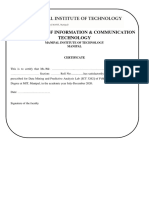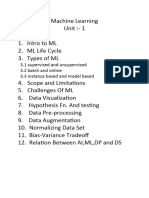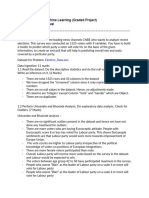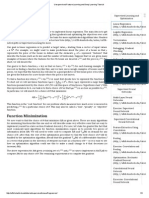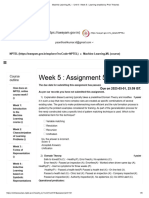0 ratings0% found this document useful (0 votes)
81 viewsMachine Learning Notes - Lec 05 - Text Claasification Using Scikit-Learn
This document outlines the steps for performing text classification using Scikit-Learn. It discusses preprocessing text data by generating n-grams from documents and labeling the data. Machine learning algorithms like Naive Bayes and logistic regression are trained on the preprocessed data. The trained models are then evaluated on test data to select the best performing model. This top model is later used to classify new unlabeled documents by extracting features from input text and making predictions. The goal is to predict the gender of authors based on Facebook comments.
Uploaded by
Zara JamshaidCopyright
© © All Rights Reserved
Available Formats
Download as PDF, TXT or read online on Scribd
0 ratings0% found this document useful (0 votes)
81 viewsMachine Learning Notes - Lec 05 - Text Claasification Using Scikit-Learn
This document outlines the steps for performing text classification using Scikit-Learn. It discusses preprocessing text data by generating n-grams from documents and labeling the data. Machine learning algorithms like Naive Bayes and logistic regression are trained on the preprocessed data. The trained models are then evaluated on test data to select the best performing model. This top model is later used to classify new unlabeled documents by extracting features from input text and making predictions. The goal is to predict the gender of authors based on Facebook comments.
Uploaded by
Zara JamshaidCopyright
© © All Rights Reserved
Available Formats
Download as PDF, TXT or read online on Scribd
You are on page 1/ 75
Machine Learning
Lecture 05
Text Classification using Scikit-Learn
Dr. Rao Muhammad Adeel Nawab
How to Work
Dr. Rao Muhammad Adeel Nawab 2
Power of Dua
Dr. Rao Muhammad Adeel Nawab 3
Dua – Take Help from Allah before starting any task
Dr. Rao Muhammad Adeel Nawab 4
Course Focus
Mainly get EXCELLENCE in two things
1. Become a great human being
2. Become a great Machine Learning Engineer
To become a great human being
Get sincere with yourself
When you get sincere with yourself your ﺧﻠﻭﺕand ﺟﻠﻭﺕis the
same
Dr. Rao Muhammad Adeel Nawab 5
Introduction
Aim
The main aim of this tutorial is to predict the
gender of an author from his/her written text
using Scikit-Learn Machine Learning toolkit.
Task
Learn Input-Output Function
Given a Facebook comment (input) predict the
gender of the author (output) who wrote it.
Dr. Rao Muhammad Adeel Nawab 6
Introduction
Goal
The problem of gender prediction is treated as a
supervised learning problem.
We need
Labelled data
High quality data
Large amount of data
Dr. Rao Muhammad Adeel Nawab 7
Input and Output
Input
Facebook Comment - Plain text only
Represented as n-grams
Note that in this tutorial we will use word uni-grams (or
1-grams) as features to represent a Facebook comment
(or text)
Output
Gender of Author who wrote the comments
Represented as Gender attribute (Male/Female)
Dr. Rao Muhammad Adeel Nawab 8
N-gram Models
An n-gram is a contiguous sequence of n items from a
given sample of text
N-gram can be
Word based
Character based
N represents the length of N-gram
Dr. Rao Muhammad Adeel Nawab 9
Example – N-gram Generation from Input Text
Input Text
R u coming?
Word Uni-grams (N = 1)
Toeknized Text:
R
u
coming
?
Set of Word Uni-grams = {R, u, coming, ?}
Dr. Rao Muhammad Adeel Nawab 10
Example – N-gram Generation from Input Text
Input Text
R u coming?
Word Bi-grams (N = 2)
Toeknized Text:
R
u
coming
?
Set of Word Bi-grams = {R u, u coming, coming ?}
Dr. Rao Muhammad Adeel Nawab 11
Example – N-gram Generation from Input Text
Input Text
R u coming?
Word Tri-grams (N = 3)
Toeknized Text:
R
u
coming
?
Set of Word Tri-grams = {R u coming, u coming ?}
Dr. Rao Muhammad Adeel Nawab 12
Example – N-gram Generation from Input Text
Input Text
R u coming?
Character Tri-grams (N = 3)
Toeknized Text:
Note that space is also a character
R, ,u, ,c,o,m,I,n,g,?
Set of Character Tri-grams
{R u, u , co,com,omi,min,ing,gn?)
Dr. Rao Muhammad Adeel Nawab 13
Three Phases of Machine Learning
Use subset of data (called Train
Training data) to train model (learning)
Use subset of data (called Test
Testing Data) to evaluate train model
Use your learned/trained models
Application in real world applications
Dr. Rao Muhammad Adeel Nawab 14
PHASE 1 & 2: TRAINING AND TESTING
Step 1: Import Libraries
Step 2: Read, Understand and Pre-process Train/Test Data
Step 2.1: Read Data
Step 2.2: Understand Data
Step 2.3: Pre-process Data
Dr. Rao Muhammad Adeel Nawab 15
PHASE 1 & 2: TRAINING AND TESTING
Step 3: Label Encoding for Train/Test Data
Step 4: Feature Extraction – Changing Representation of Data
“from String to Vector”
Step 5: Train Machine Learning Algorithms using Training Data
Step 6: Evaluate Machine Learning Algorithms using Test Data
Step 7: Selection of Best Model
Dr. Rao Muhammad Adeel Nawab 16
PHASE 3: Application Phase
Step 8: Application Phase
Step 8.1: Combine Data (Train + Test )
Step 8.2: Train Best Model (see Step 7) on all data(Train + Test)
Step 8.3: Save the Trained Model as Pickle File
Dr. Rao Muhammad Adeel Nawab 17
PHASE 3: Application Phase
Step 9: Make prediction on unseen/new data
Step 9.1: Load the Trained Model (saved in Step 8.3)
Step 9.2: Take Input from User
Dr. Rao Muhammad Adeel Nawab 18
PHASE 3: Application Phase
Step 9.3: Convert User Input into Feature Vector (Same as
Feature Vector of Trained Model)
Step 9.4: Apply Trained Model on Feature Vector of Unseen
Data and Output Prediction (Male/Female) to User
Dr. Rao Muhammad Adeel Nawab 19
Step 1: Import Libraries
Dr. Rao Muhammad Adeel Nawab 20
Step 2: Read, Understand and Pre-process Train/Test
Data
Read, Understand and Pre-process Train/Test Data
Dr. Rao Muhammad Adeel Nawab 21
Step 2.2: Understand Data
Dr. Rao Muhammad Adeel Nawab 22
Step 2.2: Understand Data
Dr. Rao Muhammad Adeel Nawab 23
Step 2.2: Understand Data
Dr. Rao Muhammad Adeel Nawab 24
Step 2.2: Understand Data
Dr. Rao Muhammad Adeel Nawab 25
Step 2.2: Understand Data
Dr. Rao Muhammad Adeel Nawab 26
Step 2.2: Understand Data
Dr. Rao Muhammad Adeel Nawab 27
Step 2.2: Understand Data
Dr. Rao Muhammad Adeel Nawab 28
Step 2.2: Understand Data
Dr. Rao Muhammad Adeel Nawab 29
Step 2.2: Understand Data
Dr. Rao Muhammad Adeel Nawab 30
Step 2.2: Understand Data
Dr. Rao Muhammad Adeel Nawab 31
Step 2.2: Understand Data
Dr. Rao Muhammad Adeel Nawab 32
Step 2.2: Understand Data
Dr. Rao Muhammad Adeel Nawab 33
Step 2.2: Understand Data
Understanding Data via
GRAPH is easy.
Let’s Go!
Dr. Rao Muhammad Adeel Nawab 34
Step 2.2: Understand Data
Dr. Rao Muhammad Adeel Nawab 35
Step 2.2: Understand Data
Dr. Rao Muhammad Adeel Nawab 36
Step 2.2: Understand Data
Dr. Rao Muhammad Adeel Nawab 37
Step 2.2: Understand Data
Dr. Rao Muhammad Adeel Nawab 38
Step 2.3: Pre-Process Data
Dr. Rao Muhammad Adeel Nawab 39
Step 2.3: Pre-Process Data
Dr. Rao Muhammad Adeel Nawab 40
Step 2.3: Pre-Process Data
Dr. Rao Muhammad Adeel Nawab 41
Step 2.3: Pre-Process Data
Dr. Rao Muhammad Adeel Nawab 42
Step 2.3: Pre-Process Data
Dr. Rao Muhammad Adeel Nawab 43
Step 2.3: Pre-Process Data
Dr. Rao Muhammad Adeel Nawab 44
Please convert data to a
form that I can
understand
Dr. Rao Muhammad Adeel Nawab 45
Step 3: Label Encoding for Train/Test Data
Dr. Rao Muhammad Adeel Nawab 46
Step 3: Label Encoding for Train/Test Data
Dr. Rao Muhammad Adeel Nawab 47
Step 4: Feature Extraction
vect = CountVectorizer(
strip_accents='unicode',
analyzer='word',
token_pattern=r'\w{1,}',
stop_words='english',
ngram_range=(1, 1),
max_features=10)
print("Parameters of TfidfVectorizer and its values:\n\n")
print(vect)
Dr. Rao Muhammad Adeel Nawab 48
Step 4: Feature Extraction
Dr. Rao Muhammad Adeel Nawab 49
Step 4: Feature Extraction
Dr. Rao Muhammad Adeel Nawab 50
Step 4: Feature Extraction
Dr. Rao Muhammad Adeel Nawab 51
Step 4: Feature Extraction
Dr. Rao Muhammad Adeel Nawab 52
Step 4: Feature Extraction
Dr. Rao Muhammad Adeel Nawab 53
Step 4: Feature Extraction
Dr. Rao Muhammad Adeel Nawab 54
Step 4: Feature Extraction
Dr. Rao Muhammad Adeel Nawab 55
Train Machine
Learning Algorithms as
I Am doing.
Dr. Rao Muhammad Adeel Nawab 56
Step 5: Train ML Algorithms using Train Data
Dr. Rao Muhammad Adeel Nawab 57
Step 5: Train ML Algorithms using Train Data
Dr. Rao Muhammad Adeel Nawab 58
Step 5: Train ML Algorithms using Train Data
Dr. Rao Muhammad Adeel Nawab 59
Step 5: Train ML Algorithms using Train Data
Dr. Rao Muhammad Adeel Nawab 60
Step 6: Evaluate ML Algorithms using Test Data
Dr. Rao Muhammad Adeel Nawab 61
Step 6: Evaluate ML Algorithms using Test Data
Dr. Rao Muhammad Adeel Nawab 62
Step 6: Evaluate ML Algorithms using Test Data
Dr. Rao Muhammad Adeel Nawab 63
Step 6: Evaluate ML Algorithms using Test Data
Dr. Rao Muhammad Adeel Nawab 64
Step 6: Evaluate ML Algorithms using Test Data
Dr. Rao Muhammad Adeel Nawab 65
Step 6: Evaluate ML Algorithms using Test Data
Dr. Rao Muhammad Adeel Nawab 66
Step 6: Evaluate ML Algorithms using Test Data
Dr. Rao Muhammad Adeel Nawab 67
Step 6: Evaluate ML Algorithms using Test Data
Dr. Rao Muhammad Adeel Nawab 68
Step 7: Selection of Best Model
Dr. Rao Muhammad Adeel Nawab 69
Step 8: Application Phase
PHASE 3: APPLICATION PHASE
Dr. Rao Muhammad Adeel Nawab 70
Step 8.1: Combine Data (Train+Test)
Dr. Rao Muhammad Adeel Nawab 71
Step 8.2: Train Best Model on All Data
Dr. Rao Muhammad Adeel Nawab 72
Step 9.2: Take Input from User
Dr. Rao Muhammad Adeel Nawab 73
Step 9.3: Convert User Input into Feature Vector
(Same ss Feature Vector of Trained Model)
Dr. Rao Muhammad Adeel Nawab 74
Step 9.4: Apply Trained Model on Feature Vector of Unseen
Data and Output Prediction to User
Dr. Rao Muhammad Adeel Nawab 75
You might also like
- Machine Learning Notes - Lec 03 - Gender Identification Using Scikit-LearnNo ratings yetMachine Learning Notes - Lec 03 - Gender Identification Using Scikit-Learn71 pages
- Machine Learning Notes - Lec 01 - Basics of Machine LearningNo ratings yetMachine Learning Notes - Lec 01 - Basics of Machine Learning109 pages
- Lecture .......... Types of Learning in Machine Learning and Machine Learning CycleNo ratings yetLecture .......... Types of Learning in Machine Learning and Machine Learning Cycle44 pages
- F.Y.B.Sc.(CS)_Lab Course I_2024_NEP15_8_2024 (1)No ratings yetF.Y.B.Sc.(CS)_Lab Course I_2024_NEP15_8_2024 (1)89 pages
- Task-by-Task-Guide_-Build-and-deploy-a-stroke-prediction-model-using-RNo ratings yetTask-by-Task-Guide_-Build-and-deploy-a-stroke-prediction-model-using-R5 pages
- Cse310 - Modern Programming Tools and Techniques-I0% (1)Cse310 - Modern Programming Tools and Techniques-I7 pages
- DATA MINING AND MACHINE LEARNING. PREDICTIVE TECHNIQUES: REGRESSION, GENERALIZED LINEAR MODELS, SUPPORT VECTOR MACHINE AND NEURAL NETWORKSFrom EverandDATA MINING AND MACHINE LEARNING. PREDICTIVE TECHNIQUES: REGRESSION, GENERALIZED LINEAR MODELS, SUPPORT VECTOR MACHINE AND NEURAL NETWORKSNo ratings yet
- Lab Manual: Jawaharlal Nehru Engineering College AurangabadNo ratings yetLab Manual: Jawaharlal Nehru Engineering College Aurangabad39 pages
- Lovely Professional University, Punjab: Detailed Plan For LecturesNo ratings yetLovely Professional University, Punjab: Detailed Plan For Lectures6 pages
- Flow Diagram of Machine Learning or Life Cycle of Machine LearningNo ratings yetFlow Diagram of Machine Learning or Life Cycle of Machine Learning91 pages
- Topic 8 - Problem Solving Concepts - Part 1_6b2a94f5cd20d4bce408735a58f95cd2No ratings yetTopic 8 - Problem Solving Concepts - Part 1_6b2a94f5cd20d4bce408735a58f95cd222 pages
- Fundamentals of Programming: UECS1643/ UECS1653No ratings yetFundamentals of Programming: UECS1643/ UECS165321 pages
- Web Development and Core Java Lab Manual V Semester: Dept. of Computer Science and EngineeringNo ratings yetWeb Development and Core Java Lab Manual V Semester: Dept. of Computer Science and Engineering54 pages
- Semester 2, 2020 Week 8: Data Mining in WEKA Tutorial/Lab Session - 7No ratings yetSemester 2, 2020 Week 8: Data Mining in WEKA Tutorial/Lab Session - 713 pages
- Unit V: Software Engineering, A Practitioner's Approach - Pressman Roger. S. TMH. (Strictly 5th Ed)No ratings yetUnit V: Software Engineering, A Practitioner's Approach - Pressman Roger. S. TMH. (Strictly 5th Ed)52 pages
- 8 Quiz Maker Automatic Quiz Generation From Text Using NLPNo ratings yet8 Quiz Maker Automatic Quiz Generation From Text Using NLP11 pages
- SAS Practice Exercise: Average Score For Each Exam?No ratings yetSAS Practice Exercise: Average Score For Each Exam?1 page
- Project Report: Online Test ApplicationNo ratings yetProject Report: Online Test Application38 pages
- Write Assembly Language Program To Check String Is Palindrome or NotNo ratings yetWrite Assembly Language Program To Check String Is Palindrome or Not15 pages
- Project Presentation Viva Question and AnswersNo ratings yetProject Presentation Viva Question and Answers4 pages
- Application of Ai in Aircraft Maintenance - The Game ChangerNo ratings yetApplication of Ai in Aircraft Maintenance - The Game Changer21 pages
- JOU4930 Artificial Intelligence Syllabus Spring 2021No ratings yetJOU4930 Artificial Intelligence Syllabus Spring 20219 pages
- A Relationship Between Research Skills and Autonomous Learning Among Postgraduate StudentsNo ratings yetA Relationship Between Research Skills and Autonomous Learning Among Postgraduate Students7 pages
- Technological Advancements Disrupting The Global Construction IndustryNo ratings yetTechnological Advancements Disrupting The Global Construction Industry19 pages
- Introduction To Deep Reinforcement LearningNo ratings yetIntroduction To Deep Reinforcement Learning7 pages
- AuthorVersion PublishedTuningHyperparametersNo ratings yetAuthorVersion PublishedTuningHyperparameters30 pages
- Optimized GAN-Based Pipeline For High-Quality Face Restoration From CCTV ImagesNo ratings yetOptimized GAN-Based Pipeline For High-Quality Face Restoration From CCTV Images29 pages
- "Sentiment Analysis of Imdb Movie Reviews": A Project Report0% (1)"Sentiment Analysis of Imdb Movie Reviews": A Project Report22 pages
- Attacking Speaker Recognition With Deep Generative Models Wilson Cai, Anish Doshi, Rafael Valle UC BerkeleyNo ratings yetAttacking Speaker Recognition With Deep Generative Models Wilson Cai, Anish Doshi, Rafael Valle UC Berkeley5 pages
- VGGFace Transfer Learning and Siamese Network For Face RecognitionNo ratings yetVGGFace Transfer Learning and Siamese Network For Face Recognition6 pages
- Problem Statements (Hardware and Software)No ratings yetProblem Statements (Hardware and Software)34 pages
- Internet of Things 18Cs81: Module - 4 Data and Analytics For IotNo ratings yetInternet of Things 18Cs81: Module - 4 Data and Analytics For Iot32 pages
- A 2022-Es Győri Közlekedéstudományi Konferencia AbsztraktköteteNo ratings yetA 2022-Es Győri Közlekedéstudományi Konferencia Absztraktkötete84 pages
- Machine Learning Notes - Lec 03 - Gender Identification Using Scikit-LearnMachine Learning Notes - Lec 03 - Gender Identification Using Scikit-Learn
- Machine Learning Notes - Lec 01 - Basics of Machine LearningMachine Learning Notes - Lec 01 - Basics of Machine Learning
- Lecture .......... Types of Learning in Machine Learning and Machine Learning CycleLecture .......... Types of Learning in Machine Learning and Machine Learning Cycle
- Task-by-Task-Guide_-Build-and-deploy-a-stroke-prediction-model-using-RTask-by-Task-Guide_-Build-and-deploy-a-stroke-prediction-model-using-R
- Cse310 - Modern Programming Tools and Techniques-ICse310 - Modern Programming Tools and Techniques-I
- Software Testing and Tooling Courseware: Based on CTAPFrom EverandSoftware Testing and Tooling Courseware: Based on CTAP
- DATA MINING AND MACHINE LEARNING. PREDICTIVE TECHNIQUES: REGRESSION, GENERALIZED LINEAR MODELS, SUPPORT VECTOR MACHINE AND NEURAL NETWORKSFrom EverandDATA MINING AND MACHINE LEARNING. PREDICTIVE TECHNIQUES: REGRESSION, GENERALIZED LINEAR MODELS, SUPPORT VECTOR MACHINE AND NEURAL NETWORKS
- Lab Manual: Jawaharlal Nehru Engineering College AurangabadLab Manual: Jawaharlal Nehru Engineering College Aurangabad
- Lovely Professional University, Punjab: Detailed Plan For LecturesLovely Professional University, Punjab: Detailed Plan For Lectures
- Flow Diagram of Machine Learning or Life Cycle of Machine LearningFlow Diagram of Machine Learning or Life Cycle of Machine Learning
- Topic 8 - Problem Solving Concepts - Part 1_6b2a94f5cd20d4bce408735a58f95cd2Topic 8 - Problem Solving Concepts - Part 1_6b2a94f5cd20d4bce408735a58f95cd2
- Web Development and Core Java Lab Manual V Semester: Dept. of Computer Science and EngineeringWeb Development and Core Java Lab Manual V Semester: Dept. of Computer Science and Engineering
- Semester 2, 2020 Week 8: Data Mining in WEKA Tutorial/Lab Session - 7Semester 2, 2020 Week 8: Data Mining in WEKA Tutorial/Lab Session - 7
- Unit V: Software Engineering, A Practitioner's Approach - Pressman Roger. S. TMH. (Strictly 5th Ed)Unit V: Software Engineering, A Practitioner's Approach - Pressman Roger. S. TMH. (Strictly 5th Ed)
- 8 Quiz Maker Automatic Quiz Generation From Text Using NLP8 Quiz Maker Automatic Quiz Generation From Text Using NLP
- SAS Practice Exercise: Average Score For Each Exam?SAS Practice Exercise: Average Score For Each Exam?
- Write Assembly Language Program To Check String Is Palindrome or NotWrite Assembly Language Program To Check String Is Palindrome or Not
- Application of Ai in Aircraft Maintenance - The Game ChangerApplication of Ai in Aircraft Maintenance - The Game Changer
- JOU4930 Artificial Intelligence Syllabus Spring 2021JOU4930 Artificial Intelligence Syllabus Spring 2021
- A Relationship Between Research Skills and Autonomous Learning Among Postgraduate StudentsA Relationship Between Research Skills and Autonomous Learning Among Postgraduate Students
- Technological Advancements Disrupting The Global Construction IndustryTechnological Advancements Disrupting The Global Construction Industry
- Optimized GAN-Based Pipeline For High-Quality Face Restoration From CCTV ImagesOptimized GAN-Based Pipeline For High-Quality Face Restoration From CCTV Images
- "Sentiment Analysis of Imdb Movie Reviews": A Project Report"Sentiment Analysis of Imdb Movie Reviews": A Project Report
- Attacking Speaker Recognition With Deep Generative Models Wilson Cai, Anish Doshi, Rafael Valle UC BerkeleyAttacking Speaker Recognition With Deep Generative Models Wilson Cai, Anish Doshi, Rafael Valle UC Berkeley
- VGGFace Transfer Learning and Siamese Network For Face RecognitionVGGFace Transfer Learning and Siamese Network For Face Recognition
- Internet of Things 18Cs81: Module - 4 Data and Analytics For IotInternet of Things 18Cs81: Module - 4 Data and Analytics For Iot
- A 2022-Es Győri Közlekedéstudományi Konferencia AbsztraktköteteA 2022-Es Győri Közlekedéstudományi Konferencia Absztraktkötete




























